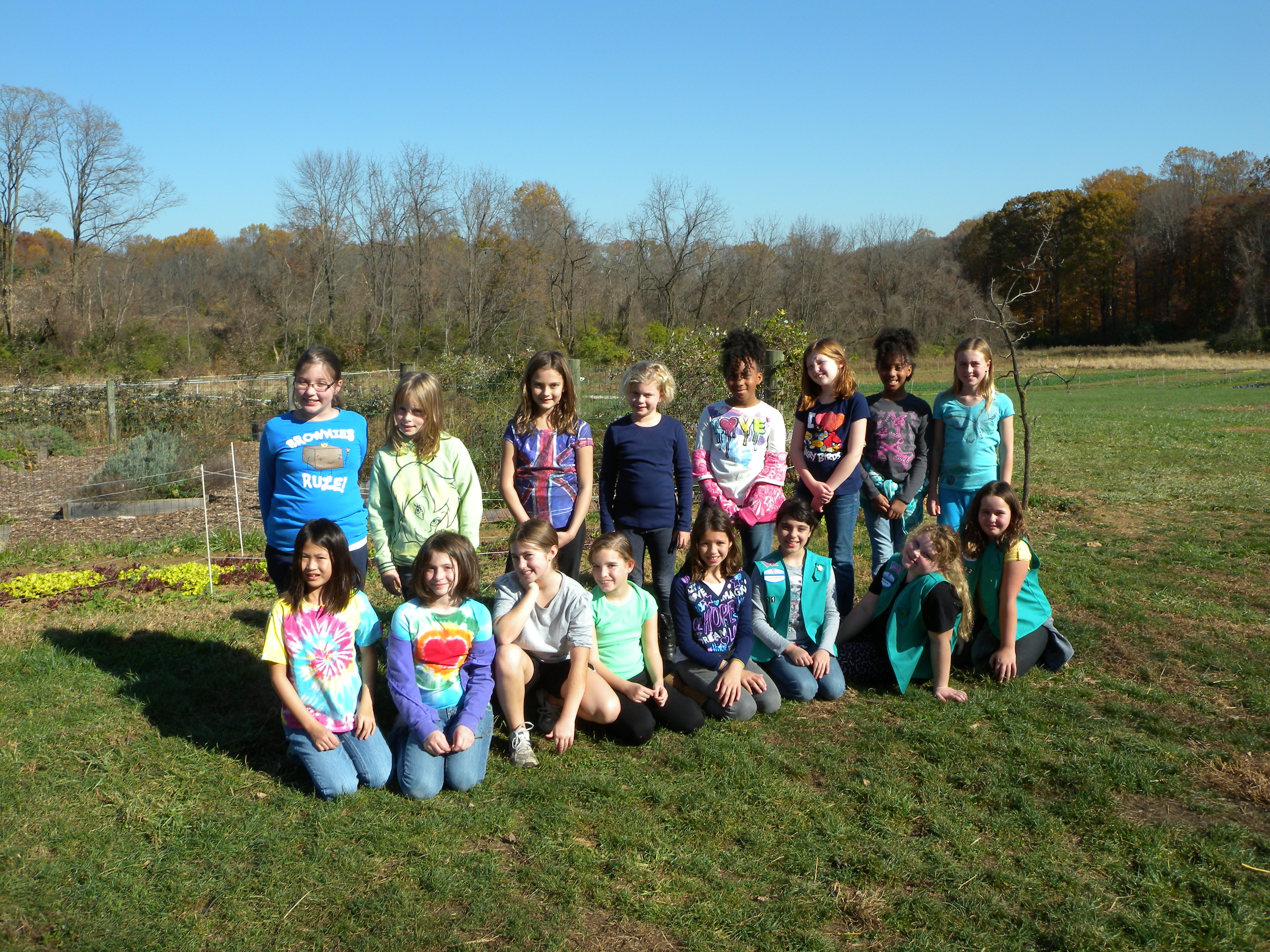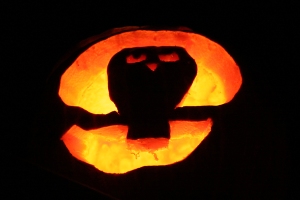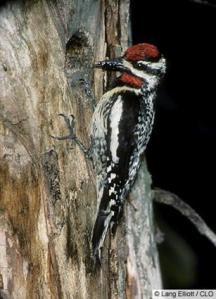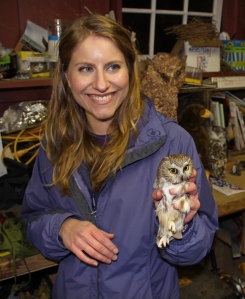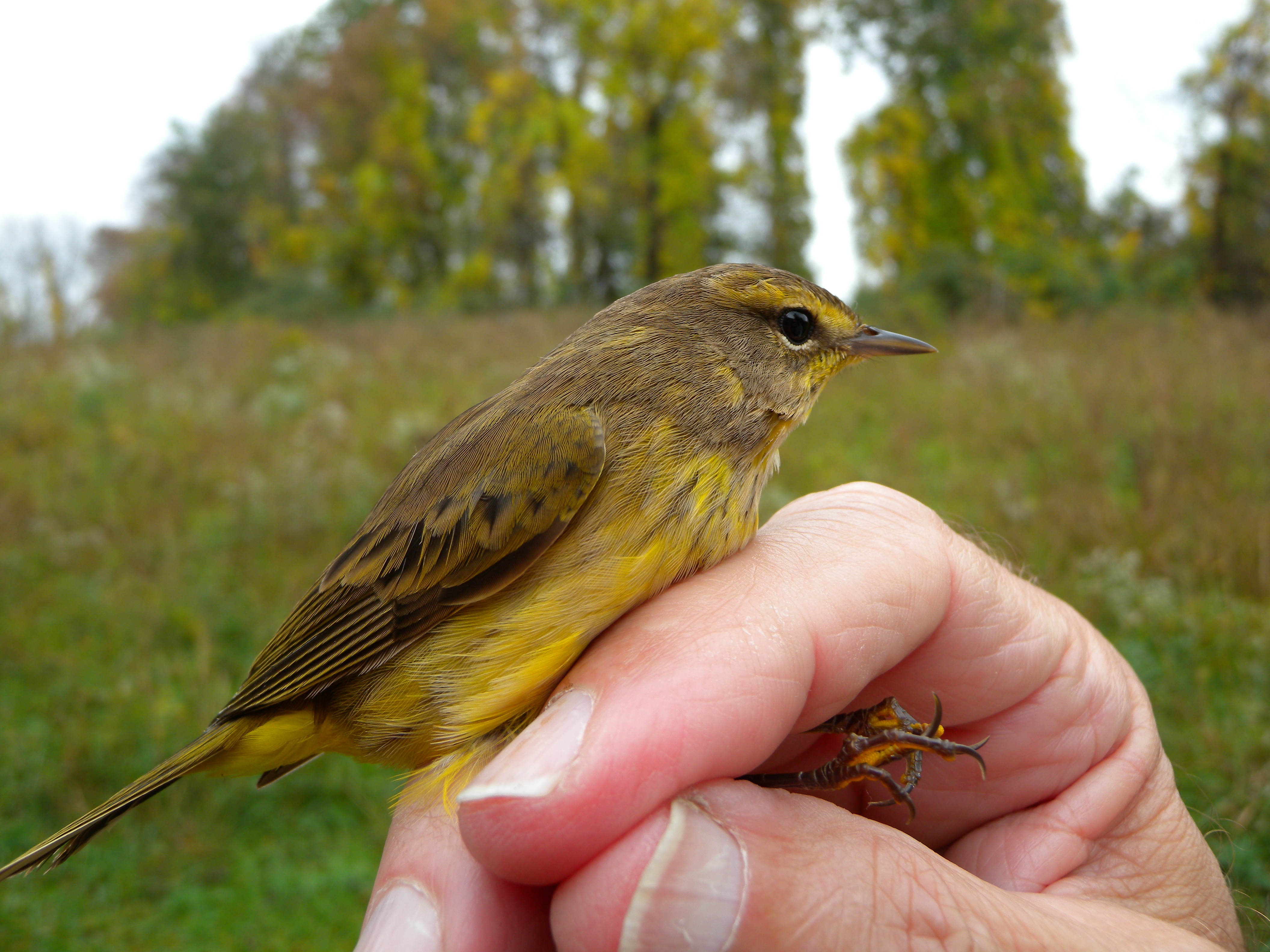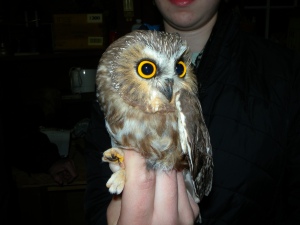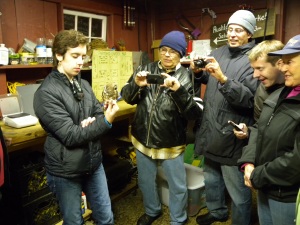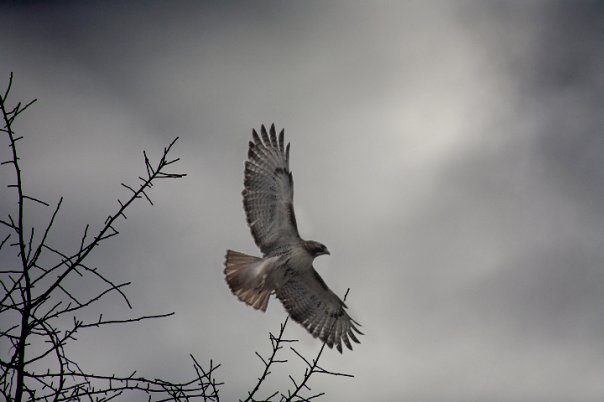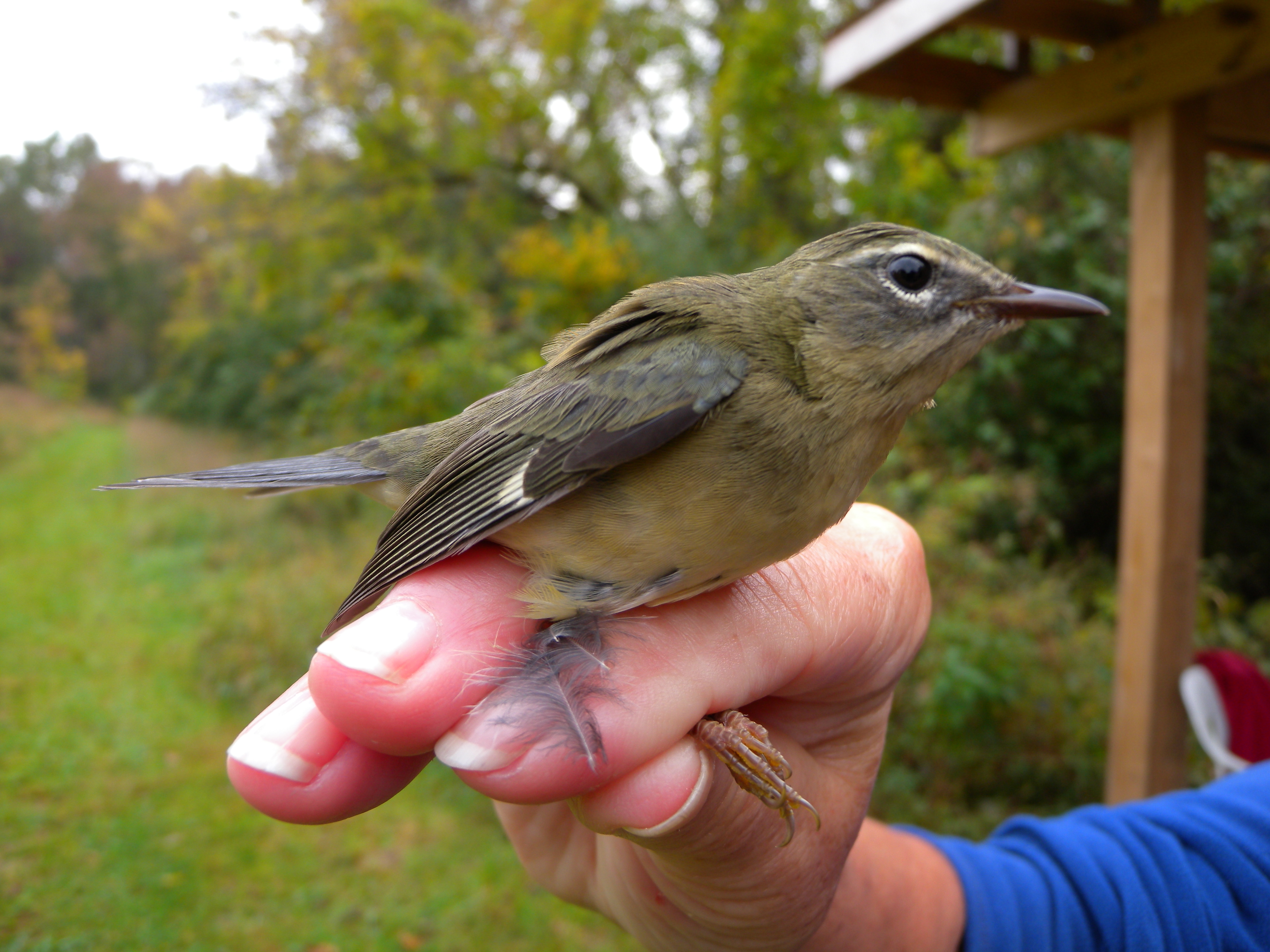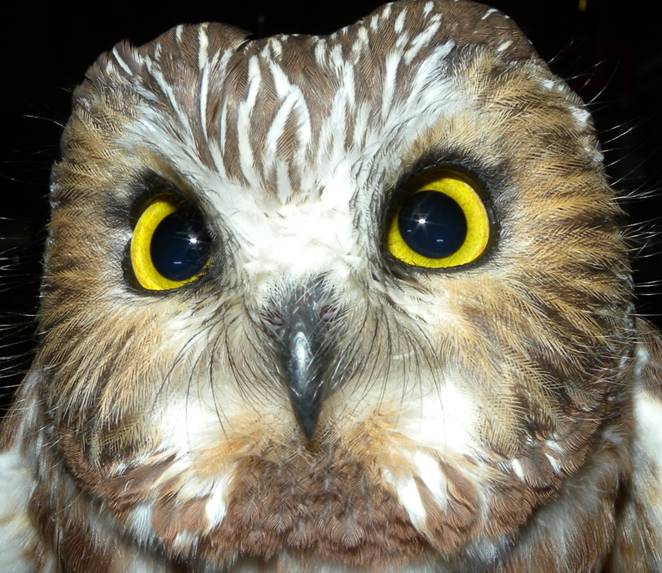Our banding station is officially closed for the year (both songbirds and owls), which means it’s time for us banders to get back in the office and put our lives (and our desks) back together again! We tried a few more times for owls around Thanksgiving when we heard that other banding stations both north and south of us were getting more owls. King’s Gap in Cumberland County (one of Scott Weidensaul’s banding stations northwest of us) caught 5 new Saw-whets on November 23rd! On November 21st Glenn Proudfoot, another owl bander in Poughkeepsie, NY, actually hand-plucked one female Saw-whet off of a rope that was holding one of his net poles up! She was not in the net and was totally free to fly away at any moment if she wished. This is not so unusual considering the surprisingly calm nature of some of these individuals. What is most notable about this story is that he named the owl Marsha Mellow! 🙂
We opened our nets the night after with high hopes and caught nothing…although we did see a flying squirrel spying on us and hear Saw-whet Owls calling in the woods. We suspect there are a couple of owls that decided to overwinter in our area, and they have grown weary of investigating the invisible, loud-mouthed male that sings for hours on end during some nights, in the midst of giant spider webs!

Coincidentally, the very last Saw-whet Owl we captured this year (on November 19th) was the very first owl we caught this year (October 21st). We have no way of knowing if this young female (band # 37) was here the entire time or if she wandered many miles away and came back, which is very likely considering the nomadic nature of these woodland elves in winter (as discussed in my last blog post). In any case, it certainly seems that #37 is at least using Rushton as her home base this winter. Don’t forget, however, that these spritely owls have the ability to travel far and wide if they want to; this fall, one young female was reported to have traveled from a banding station in Ontario to one in Alabama in just one month!

Our Saw-whet Owl total for the season is just 34, which is a comparable low to other banding stations in the east. The grande total ( a new all time low) for all three of Scott Weidensaul’s PA stations (King’s Gap, Hidden Valley, and Small Valley) is 116 as of November 30th; the previous low total for his stations was 201 in 2006. Last year, he banded over 340 owls across all 3 sites, and we banded 91 owls here at Rushton Woods Preserve. That was one of the best years so far.
I have not heard a definitive answer to the question of why there were so few owls showing up at eastern banding stations this year, although most banders agree that the resources up north were probably insufficient during the owls’ breeding season this year. The majority of banding stations banded more adult and less Hatch Year owls (birds born this summer) this year than previous years. This could be an indication that there weren’t many baby owls this year as a result of low breeding success; either the parents did not have the resources to have many babies, there was high juvenile mortality caused by lack of food or it was a combination of both scenarios. In certain previous years, lower numbers of Saw-whets traveling south actually meant that the resources up north were abundant, thus diminishing the need to migrate in winter. However, the low totals we saw this year coupled with the lower ratio of Hatch Years to adults is a sure sign that the little fuzzballs had a rough summer.

Even the Saw-whets’ plumage revealed evidence of stress. Just to give you some background, we age birds based on their species-specific molt patterns, with particular emphasis on the flight feathers. Molting requires a great deal of energy and nutrients, so a bird born this year (Hatch Year-HY) will not usually carry out a complete molt; it may molt all of its body feathers and only some of its flight feathers. The “unmolted” feathers are called retained juvenile feathers and usually appear dingier, lighter in color and more worn than the fresh molted feathers. We think of these retained juvenile feathers as the “cheap Kmart feathers”! The boundaries between tracts of new and old feathers are called molt limits.

An HY Saw-whet Owl will usually show no molt limit because they do not replace any of their juvenile feathers in their first fall. They have too many other things to be worrying about, like learning to hunt and stay alive! Therefore, an HY Saw-whet has all uniformly “trashy” looking flight feathers. A Second Year (SY) owl usually shows a molt pattern of several outermost primaries and innermost secondaries replaced; these feathers look darker and have less nicks than all the flight feathers in between. However, this year banders were seeing more SY birds with only a few outermost primaries replaced and no inner secondary feathers replaced. Such suspended flight feather molt is most likely another result of lack of adequate resources on the northern breeding grounds where the bird molted after mating.

We are certainly thankful for the few beautiful owls that Mother Nature did send our way this year, and we wish them the best of luck as they survive the winter and return to their breeding grounds that will hopefully present better conditions in the new year! These owls are truly amazing little creatures, more adorable than the cutest stuffed animal, as whimsical as a fairy tale gnome, as silent and elusive in flight as the Luna moth, as mellow and approachable as a garden toad, more formidable a hunter than a wild cat, and at times as ferocious as a miniature fire-breathing dragon!
You can’t help but love them and be captivated by their steadfast, yellow-eyed gaze. I find myself wishing I knew what she knows, yearning to see the wild places she has seen, longing for the untamed solitude she has experienced, craving to fly on wings of silence through the night, and wanting to be close to her as a friend. She embodies nature at its finest.

Thank you to all who came out to our bird banding station this year, bringing interest, enthusiasm, and support. We are thrilled to be able to connect people to the nature that makes us whole, feeds our soul, and renews the bonds between us and the land from which we so easily become isolated.
A special thanks to our dedicated group of PA Young Birders who have been regularly attending our monthly meetings! We had fun at last month’s meeting learning about cavity nesting birds, looking for old bird nests in Rushton Woods Preserve and drawing our favorite cavity nesting birds. The Jr. Birders even learned how to use power tools to help make a bluebird box that the Trust will install on one of our properties!


Don’t miss this month’s meeting, “A Winter Bird Count”, on Saturday, December 17th from 9 AM – 1PM. PA Young Birders, ages 8-12, will meet at the Willistown Conservation Trust headquarters (925 Providence Road, Newtown Square, PA) where we will learn how to identify wonderful winter birds. Then we’ll learn about the honored tradition of the Christmas Bird Count before heading out into the field with our binoculars to see what we can see! We’ll return to the office for a Tally Rally of the birds we counted, while enjoying hot pizza and cocoa by the fire. Be sure to wear lots of holiday cheer and many warm layers! Please RSVP to Lisa Kiziuk (lkr@wctrust.org).

The Christmas Bird Count began in 1900 by a man, named Frank Chapman, who proposed counting the birds instead of shooting them. Unfortunately, it had been a holiday sport for local farmers and residents to shoot as many birds as they could until sensible people, like Frank, began showing concern about alarming declines in bird populations. Today, the Christmas Bird Count is the largest wildlife survey in the world.

You don’t have to be a kid to participate in the spirited tradition of the Christmas bird Count! You also don’t need to be an expert birder; since there is a specific protocol and the data is very important, beginner birders will be placed in a team with at least one other experienced birder. The Christmas Bird Count season is December 14 through January 5 each year. To learn more about this elaborate citizen science project and to find participating birders near you, go to Audubon’s website. It’s a great way to meet new people, build your birding skills, experience nature in winter and contribute to the conservation of birds during this season of giving. Plus, hot chocolate tastes better than ever after hours of winter bird counting!

Speaking of searching for birds in winter, be sure to keep your eye out for SNOWY OWLS!!! Like the Northern Saw-whet Owl, the Snowy Owl is an irruptive species that is closely tied to the rodent population on their northern breeding grounds, especially lemmings. This is an irruption year for Snowy Owls, which means that the dramatic decrease in lemmings is drawing them south from their usual Arctic Tundra territories in search of food. So far this winter, there have been over 100 reports of these Arctic ghosts in Wisconsin and other midwestern states and even one in Hawaii! Just over a week ago, a Snowy Owl was reported by several individuals east of Allentown on the PA/NJ border!

These magnificent rare beauties are coming our way. Stay tuned for when one shows up near us….you can bet the bird nerds, like me, here at the Willistown Conservation Trust will ‘stop, drop, and bird’ at the first local report of a Snowy Owl! The last time a Snowy Owl irruption of this magnitude occured was in 2006. Interestingly enough, 2006 was also the runner-up to this year in setting the record low for numbers of Saw-whet Owls traveling south from their northern haunts. Here’s a Google Map of Snowy Owl sightings so far this year, and click here to read a recent article in the Wisconsin State Journal about the 2011 Snowy Owl irruption.

Wishing you happiness in your home and a bounty of birds at your feeder this holiday season!
~Blake




